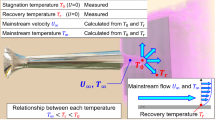Abstract
Microelectromechanical systems (MEMS) sensors are increasingly used for measurements in fluid dynamics since, because of their inherently compact size, they allow access to the information that was previously unavailable. In this paper we describe further testing of a MEMS sensor used to measure surface shear stress. It is a wall-mounted fence that bends under the influence of the pressure difference resulting from the velocity shear at the wall. The fences have been successfully calibrated in a wind tunnel and, as an example of their application, used to determine mean and fluctuating shear stress (along with spectra) in a cylindrical cavity flow.
















Similar content being viewed by others
References
Alfredsson H, Johansson AV, Haritonidis JH, Eckelmann H (1988) The fluctuating wall-shear stress and the velocity field in the viscous sublayer. Phys Fluids 31:1026–1033
Barlian AA, Park S-J, Mukundan V, Pruitt BL (2007) Design and characterisation of microfabricated piezoresistive floating element-based shear stress sensors. Sens Actuators A 134:7787
Brücker C, Spatz J, Schröder W (2005) Feasibility study of wall-shear stress imaging using microstructured surfaces with flexible micropillars. Exp Fluids 39:464–474
Castro IP, Dianat M, Bradbury LJS et al (1987) The pulsed wire skin friction technique. In: Durst F (eds) Turbulent shear flows, vol V, Springer, Berlin
Chandresakaran V, Cain A, Nishida T, Cattafesta LN, Sheplak M (2005) Dynamic calibration techniques for thermal shear-stress sensors with mean flow. Exp Fluids 39:56–65
Chernyshenko S (2009) VortexCell2050: fundamentals of actively controlled flows with trapped vortices. EU Executive summary report for contract no. AST4-CT-2005-012139, http://cordis.europa.eu/documents/documentlibrary/120142501EN6.pdf
Fernholz HH, Janke G, Schober M, Wagner P, Warnack D (1996) New developments and applications of skin-friction measuring techniques. Meas Sci Technol 7:1396–1409
Grosse S, Schröder W (2008) Mean wall-shear stress measurements using the micro-pillar shear-stress sensor MPS3. Meas Sci Technol 19:015403
Grosse S, Schröder W (2009) High Reynolds number turbulent wind tunnel boundary layer wall-shear stress sensor. J Turbul 14:1–12
Hanratty T, Campbell J (1983) Measurement of wall shear stress. In: Goldstein RJ (eds) Fluid mechanics measurements, Hemisphere, New York, pp 559–615
Haritonidis N (1989) The measurement of wall shear stress. In: el Hak MG (eds) Fluid mechanics measurements, Springer, Berlin, pp 229–261
Ho CM, Tai YC (1996) Review: MEMS and its application to flow control. J Fluids Eng 118:437–447
Hu Z, Morfey CL, Sandham ND (2006) Wall pressure and shear stress spectra from direct numerical simulations of channel flow. AIAA J 44:1541–1549
Johansson AV, Alfredsson PH (1983) Effects of imperfect spatial resolution on measurements of wall-bounded turbulent shear flows. J Fluid Mech 137:409–421
Kasagi N, Suzuki Y, Fukagata K (2006) Microelectromechanical systems-based feedback control of turbulence for skin friction reduction. Ann Rev Fluid Mech 41:231–251
Konstantinov N, Dragnysh G (1960) The measurement of friction stress on a surface (English translation DSIR RTS, 1499)
Löfdahl L, el Hak MG (1999) MEMS-based pressure and shear-stress sensors for turbulent flows. Meas Sci Technol 10:665–686
Padmanabhan A, Sheplak M, Breuer KS, Schmidt MA (1997) Micromachined sensors for static and dynamic shear-stress measurements in aerodynamic flows. In: Solid state sensors & actuators, Transducers’97, Chicago, pp 137–140
Patel VC (1964) Calibration of the Preston tube and limitations on its use in pressure gradients. J Fluid Mech 23:185–208
Savelsberg R, Castro IP (2009) Vortex flows in open cylindrical cavities. Exp Fluids 46:485–497
Schiffer M, Obermeier E, Grewe F, Ebner A, Fernholz HH (2005) A new height-adjustable AeroMEMS surface fence probe fabricated in SOI technology for high resolution wall shear stress measurement in turbulent flows. In: Proceedings of 13th international conference on solid-state sensors and actuators (Transducers’05), Seoul, June, pp 601–604
Schiffer M, Obermeier E, Grewe F, Ebner A, Fernholz HH (2006) AeroMEMS surface fence for wall shear stress measurements in turbulent flows. In Proceedings of 44th AIAA aerospace sciences meeting and exhibit, Reno, 9–12 Jan
Schlichting H (1979) Boundary layer theory. 7th edn. McGraw-Hill, London
Schober M, Obermeier E, Pirskawetz S, Fernholz HH (2004) A MEMS skin-friction sensor for time resolved measurements in separated flows. Exp Fluids 36:593–599
Sheplak M, Padmanabhan A, Schmidt M, Breuer K (2001) Dynamic calibration of a shear-stress sensor using Stokes-layer excitation. AIAA J 39:819–831
Sheplak M, Chandrasakaran V, Cain A, Nishida T, Cattafesta L (2002) Characterisation of a micormachined thermal shear stress sensor. AIAA J 39:819–823
Tutty O, Savelsberg R, Castro IP (2012) Three-dimensional flow in circular cavities of large aspect ratio. J Fluid Mech (under review)
von Papen T, Ngo HD, Obermeier E, Schober M, Pirskawetz S, Fernholz HH (2001) A MEMS surface fence sensor for wall shear-stress measurement in turbulent flow areas. In: Obermeier E (ed) Transducers01/Eurosensors XV, Digest of Technical Papers, 11th international conference on solid-state sensors and actuators, München, 10–14 June. Springer, Berlin
von Papen T, Buder U, Ngo HD, Obermeier E (2004) A second generation MEMS surface fence sensor for high resolution wall shear-stress measurement. Sens Actuators A 113:151–154
Winter K (1977) An outline of techniques available for the mesaurement of skin friction in turbulent boundary layers. Prog Aerosp Sci 18:1–57
Acknowledgments
The work performed in Southampton was funded by the European Union as part of FP6. The help of the School’s EDMC workshop staff and laboratory technicians is also greatfully acknowledged. The experiments described in this paper were performed using the EnFlo software package (written using LabVIEW™), developed and maintained by the University of Surrey; we thank in particular Dr Paul Hayden for his ongoing support. The design and manufacture of the MEMS sensors was partly funded by the Deutsche Forschungsgemeinschaft (Sfb 557 TP C2) and this support is gratefully acknowledged.
Author information
Authors and Affiliations
Corresponding author
Rights and permissions
About this article
Cite this article
Savelsberg, R., Schiffer, M., Obermeier, E. et al. Calibration and use of a MEMS surface fence for wall shear stress measurements in turbulent flows. Exp Fluids 53, 489–498 (2012). https://doi.org/10.1007/s00348-012-1304-6
Received:
Revised:
Accepted:
Published:
Issue Date:
DOI: https://doi.org/10.1007/s00348-012-1304-6




